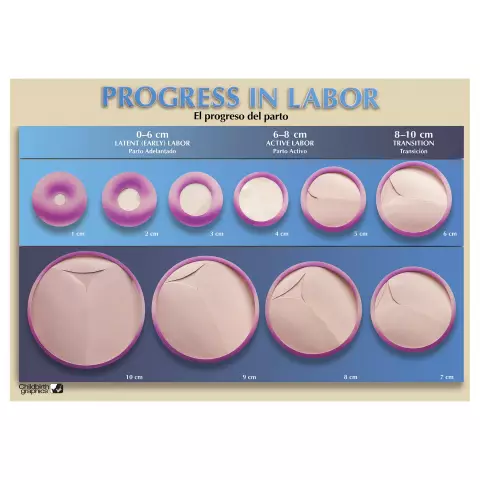- Author Rachel Wainwright [email protected].
- Public 2023-12-15 07:39.
- Last modified 2025-11-02 20:14.
Dilation of the cervix during childbirth

The onset of labor is the appearance of regular contractions, under the influence of which the cervix begins to open. Also, this process is facilitated by the pressure and weight of the fetal bladder. The gradual expansion continues for 8-14 hours and ends with the outflow of amniotic fluid and full disclosure. Then the fetus is directly expelled.
How is the cervix dilated
A woman's uterus is a hollow organ made up of muscle tissue. Around the throat is a ring of muscles - the cervix. It is closed throughout pregnancy. The entrance to it is protected by a mucous plug, which is a barrier to the penetration of infections. The cervix is quite dense, it looks like a cylinder 3 cm wide and about the same length. In the center is the cervical canal. After 32-34 weeks of pregnancy, the cervix gradually opens and softens.
On internal examination, the uterine pharynx misses the tip of the finger. The fetus begins to descend into the pelvis, thereby creating a certain pressure on the neck, which contributes to its further opening. By 36-38 weeks, the cervix is already completely flattened. The expansion begins with the internal pharynx, which in primiparous has the shape of a funnel with the base facing upwards. Gradually moving forward, the fetus stretches the outer pharynx. In multiparous women, cervical dilatation is easier, and the internal and external pharynx expand almost simultaneously.
With each contraction, under the influence of hormones, the cervix first opens to the finger, then to two. At the time of delivery, the full extension is 10 centimeters in diameter. With this degree of disclosure, the baby's head and torso will be able to pass through the birth canal.
In total, three phases are distinguished in the first stage of labor:
- The latent phase begins with regular contractions of one to two in ten minutes. At this time, the cervix is shortened and smoothed. The duration of this phase is on average 4-6 hours. Contractions during this period, as a rule, are not painful;
- The active phase is characterized by an increase in labor. The intensity of the contractions increases, becoming more frequent, strong and painful. The opening of the cervix from 2 fingers increases to about 8 centimeters. The duration of this period is from 4 to 6 hours;
- The transitional phase begins when the cervix has almost completely opened, and the intensity of contractions is more often than once every seven minutes. After this comes some weakening of labor. The duration of the phase ranges from 20 minutes to 1-2 hours; in multiparous, it may be absent.
Also, during the active phase, amniotic fluid is usually ruptured due to an increase in intrauterine pressure. The volume of the liquid is approximately 150-200 ml. Normally, amniotic fluid should be clear and light. If, when the cervix of the uterus is dilated by 6-8 centimeters, the water does not spontaneously depart, then usually the obstetrician performs an amniotomy - opening the fetal bladder.
If the cervix does not open
During the entire first birth period, constant monitoring of the condition of the woman in labor and the fetus is carried out. They monitor the course of labor, the absence of complications, the well-being of the pregnant woman (pulse rate, blood pressure, discharge from the genital tract, temperature), dilatation of the cervix.
For the timely diagnosis of intrauterine hypoxia during contractions and the prevention of possible fetal death, constant cardiac monitoring is performed. The most commonly used is indirect cardiotocography, where the heart rate is measured using ultrasound.
The fact that the birth canal of a woman is prepared is evidenced by the opening of the cervix to the finger or more. This is determined by a manual method, which is called an internal survey. It is carried out with sterile gloves, and the entrance to the vagina is treated with a disinfectant solution. The midwife can thus determine the degree of cervical readiness, the state of the amniotic fluid, the position of the child and the height of the head.
If the cervix does not open, and the woman is about to give birth, then in this case, stimulation is done. It is also usually performed after 40 weeks of pregnancy, since the placenta is aging and cannot fully perform its functions. Artificial preparation of the pharynx is carried out in two ways: medication and non-medication.
The first method is used only in a hospital setting, while the dilation of the cervix is carried out using drugs:
- Full-length introduction of kelp sticks into the cervical canal. Under the influence of moisture, after about 4-5 hours, the sticks begin to swell, thereby expanding the hole. In addition, kelp secrete endogenous prostaglandins, which accelerate the maturation of the cervix, thereby preparing it for childbirth;
- The use of artificial prostaglandin in the form of suppositories or gel. This allows you to achieve the desired result in a few hours;
- Also, the dilation of the cervix is accelerated after piercing the fetal bladder. As a result, the fetal head descends, thereby increasing pressure on the canal.
The non-drug method can be used independently, but at the same time be extremely careful:
-

First stage of labor - dilatation of the cervix A cleansing enema irritates the back of the uterus, causing it to contract. It also helps the rapid discharge of the mucous plug, accelerating the course of labor. It is necessary to do it only for those women who have already had the expected date of birth, that is, a full-term baby;
- Having sex is also a stimulant to open the cervix by 2 fingers or more. The fact is that semen contains prostaglandins, which are part of the substances used in the hospital to accelerate labor. However, if the mucous plug has already moved away, then this method is not recommended to use, so as not to bring the infection into the uterus;
- Exercise (mopping, cleaning the house, walking up or down stairs) is another way to better prepare your cervix for childbirth. But the main thing is not to overdo it, especially if there is a history of hypertension, preeclampsia or placenta previa.
In some cases, it is necessary to pre-hospitalize a woman in a hospital to prepare for the upcoming birth. Doctors will conduct an in-depth laboratory, clinical and instrumental examination there to select the timing and methods of delivery.
YouTube video related to the article:
Found a mistake in the text? Select it and press Ctrl + Enter.






